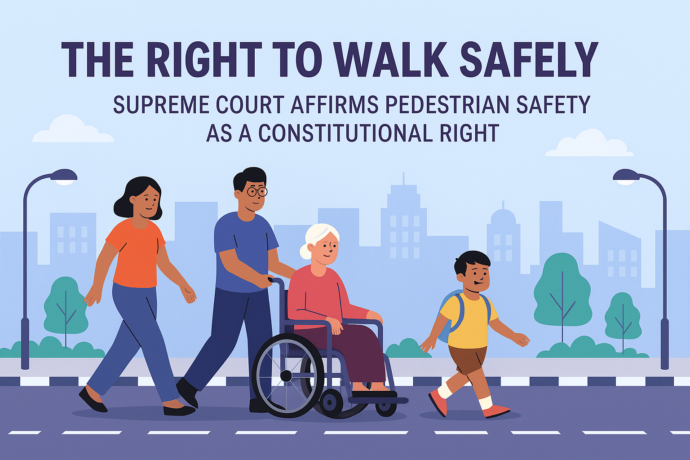the right to walk: supreme court of india affirms footpaths as a constitutional right

In a landmark judgment, the Supreme Court of India has declared that the right to walk safely on unobstructed footpaths is a fundamental right under Article 21 of the Constitution. This ruling comes as a much-needed intervention in a country where walking, one of the most basic human activities, is often unsafe, undignified, and in many cases, life-threatening.
The Ground Reality
Despite constitutional guarantees, pedestrians in India face daily challenges due to inadequate infrastructure. As per the Times of India, in 2023, approximately 35,000 pedestrians were killed in road accidents in India. This represents a significant portion of the total road accident fatalities, with every fifth death being a pedestrian. In 2022, the number of pedestrian fatalities was around 32,825, showing a substantial increase from 15,746 in 2016. In Nagpur, for instance, pedestrians accounted for 30% of road accident fatalities in 2024, primarily due to the lack of proper footpaths
A Constitutional Ruling With Urgency
A Bench of Justices Abhay S Oka and Ujjal Bhuyan made it clear:
“Unobstructed footpaths are not a luxury — they are a constitutional right.”
The Court has directed all States and Union Territories to draft and submit pedestrian safety guidelines within two months, with special emphasis on the needs of persons with disabilities. This isn’t a soft advisory—it’s a constitutional reminder.
Why It Matters
According to the Ministry of Road Transport and Highways, pedestrians account for 19.5% of all road fatalities in India (2022 data). That’s nearly one in five deaths.
And the reasons aren’t hard to find:
- Encroached or non-existent footpaths
- Cracked, uneven surfaces
- Lack of tactile tiles or ramps for the disabled
- Poor lighting and unsafe crossings
What’s worse? In many cities, footpaths are routinely taken over by parked vehicles, vendors, or broken infrastructure, leaving the elderly, children, and persons with disabilities to fend for themselves on busy roads.
This ruling is not just about urban design, it’s about saving lives.
Legal Backbone: Article 21 in Action
The Court backed its directive with the landmark Olga Tellis v. BMC (1985) case, where it first recognised the right to livelihood (and by extension, the right to walk) under Article 21. The current judgment sharpens that focus, stating:
“Without safe footpaths, people are forced to walk on roads — increasing accident risk and violating their right to life.”
This signals a legal and moral duty for governments to not just allow, but ensure safe pedestrian access in urban spaces.
Who’s Accountable?
The Supreme Court held road-owning agencies responsible. This includes:
- National Highways Authority of India (NHAI)
- State Public Works Departments (PWDs)
- Urban Local Bodies and Municipal Corporations
All these agencies are now required to follow existing Indian Roads Congress (IRC) standards and Ministry of Urban Affairs guidelines. The Court also emphasised that pedestrian infrastructure must be inclusive, taking into account wheelchair users, senior citizens, children, and the visually impaired.
What Happens Next?
⏳ States and UTS have a 2-month deadline to submit frameworks for pedestrian safety.
🏛️ The Union Government must report on its progress with a national pedestrian policy.
🚧 The Court also ordered the establishment of a National Road Safety Board within six months, bringing long-awaited institutional accountability into focus.
Call to Action: Reclaim the Footpath
This judgment opens the door. Now it’s up to citizens, planners, and civil society to walk through it—literally and figuratively.
📢 Tag your city’s municipal body.
📸 Document unsafe footpaths.
💬 Speak up—online and offline.
Because the right to walk shouldn’t be a battle. It should be a given.
Are you an urbanist, architect, or city lover? Urban Voices invites contributions on humane urbanism. Share your perspective at urbanvoicesin@gmail.com to join the dialogue.
